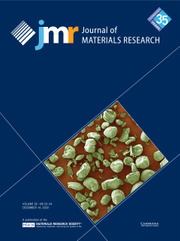Article contents
Structural and superconducting properties of melt-grown Y–Ba–Cu–O superconductors
Published online by Cambridge University Press: 31 January 2011
Abstract
YBa2Cu3O7 (123) samples with varying Y2BaCuO5 (211) concentrations (0 mol%, 20 mol%, 28 mol%, and 50 mol%) were synthesized by the melt-growth process. Microstructural characterizations were done using x-ray diffraction (XRD), optical microscopy, scanning electron microscopy, and transmission electron microscopy (TEM). It was found that 123 platelet width, crack width between the platelets, and 211 particle size decreased systematically with increasing 211 concentration. TEM study showed that there is a critical radius of curvature (rc ≤ 0.2 μm-0.3 μm) of the 123/211 interface where defects/contrasts of strain field start to appear, and these defects are believed to be responsible for pinning the magnetic flux. Microhardness measurements showed that Vickers hardness (VHN) increases with increasing 211 content. Critical current density (Jc) values obtained from magnetization measurements using a SQUID magnetometer were found to increase in melt-grown samples by the addition of 211 content.
Information
- Type
- Articles
- Information
- Copyright
- Copyright © Materials Research Society 1996
References
REFERENCES
- 1
- Cited by

